Compressed air dryer
Compressed air dryers are special types of filter systems that are specifically designed to remove the water that is inherent in compressed air. The process of compressing air raises its temperature and concentrates atmospheric contaminants, primarily water vapor. Consequently, the compressed air is generally at an elevated temperature and 100% relative humidity. As the compressed air cools, water vapor condenses into the tank(s), pipes, hoses and tools that are downstream from the compressor.
Excessive liquid and condensing water in the air stream can be extremely damaging to equipment, tools and processes that rely on compressed air. The water can cause corrosion in the tank(s) and piping, wash out lubricating oils from pneumatic tools, emulsify with the grease used in cylinders, clump blasting media and fog painted surfaces. Therefore, it is desirable to remove condensing moisture from the air stream to prevent damage to equipment, air tools and processes. The function of removing this unwanted water is the purview of the compressed air dryer.
There are various types of compressed air dryers. These dryers generally fall into two different categories, Primary and Secondary. Their performance characteristics are typically defined by flow rate in Standard Cubic Feet per Minute (SCFM) and dew point expressed as a temperature, (sometimes referred to as Pressure Dew Point.)
Primary Dryers: Coalescing, Refrigerated and Deliquescent.
Secondary Dryers: Desiccant, Absorption and Membrane.
Applications
Water contamination is an inherent byproduct of compressing atmospheric air. Because of this phenomenon, compressed air systems usually benefit from the addition of a compressed air dryer located on the output of the air compressor and/or at various locations throughout the distribution system. In most cases, the output of the compressor is processed through a primary dryer or system dryer. In cases where higher quality air is required the output of the primary dryer is further processed through a secondary dryer or polishing dryer.
Coalescing Filters
Coalescing filters aren’t actually filters, rather they operate more as a consolidation element. The idea behind these devices is that the compressed air is forced through gaps or porosity within an otherwise solid
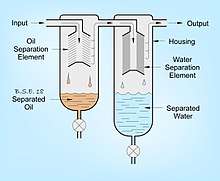
element. These gaps and/or porosity are microscopic and small enough that water vapor wets to the internal surfaces. The liquid water that forms during the wetting process is forced through the media and drips down into a trap. The dry air travels up to and out of the discharge port.
There are two basic types of coalescing elements. The first type utilizes a cast material that is dominated with an internal microscopic lattice. The air is forced to flow through the lattice which, in turn, allows the water vapor to wet to the internal surfaces. The second type is generally referred to as a stacked plate element. In this case, fine discs are stacked with microscopic gaps between them. The air is forced to flow through the gaps which, in turn, allows the water vapor to wet to the internal surfaces.
In principle, a coalescing filter is an ideal way to separate water from the compressed air stream. Practically speaking, this is not the case. Coalescing elements are extremely sensitive to oil and particulate contamination and therefore would be better placed as a second stage dryer. However, the dew point performance of a coalescing filter places it in the primary category of compressed air dryers. In order to use coalescing filters as primary dryers, they are typically set-up in pairs. The first filter has an element with larger gaps that are designed to remove oil from the stream. The second filter uses a finer element that is intended to remove water vapor. Because of the sensitivity of the elements, coalescing filters are not particularly common. One area where these filters have found acceptance is with dental compressors. The way that dental compressors are designed and used makes a two stage coalescing filter an almost ideal solution for water contamination in these systems.
Refrigerated Dryers
Refrigerated dryers are the most common type of compressed air dryer. They remove water from the air stream by cooling the air to approximately 38 °F and effectively condensing out the moisture in a

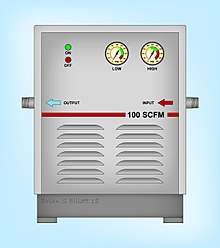
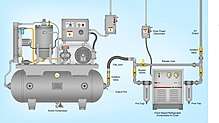
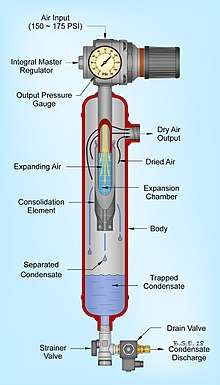

controlled environment. 38 °F is the realistic lower limit for a refrigerated dryer because a lower temperature runs the risk of freezing the separated water. They are typically specified as primary dryers and generally produce air quality that is appropriate for approximately 95% of all compressed air applications. Refrigerated dryers are generally manufactured in one of two different ways, Freon based units and Joule-Thomson based units.
Freon Based Refrigerated Compressed Air Dryers
These dryers derive their cooling from a closed cycle refrigeration system based around one of three commercial refrigerants, R-22, R-134a or R410a. The refrigeration system these dryers use is similar to home and commercial air conditioning systems. The schematic shown to the right illustrates a typical Freon based refrigerated compressed air dryer.
Freon based refrigerated compressed air dryers generally consist of a heat exchanger that is similar to a water cooled after cooler. Instead of using water as the coolant, liquid CFC fills the shell of the heat exchanger. The liquid CFC is maintained at a pressure that allows it to boil at 38 °F. After the CFC boils, the vapor is drawn through the suction line into a compressor, which compresses the CFC to a high pressure and high temperature. The high pressure/temperature CFC is cooled in the condenser and relaxes into its liquid state. The liquid is reintroduced into the heat exchanger via the metering device and a closed refrigeration cycle is formed. When the compressed air passes through the heat exchanger, it is cooled to the temperature of the boiling CFC. As the compressed air is cooled, it loses its ability to retain moisture and the water vapor condenses onto the inside of the exchanger tube.
See Also: Vapor-compression refrigeration
Variations on this basic design include units equipped with reheating exchangers, which are intended to improve efficiency. In these cases, the cooled compressed air is reheated by the incoming air.
High temperature dryers are equipped with an additional pre-cooler that removes excess heat via a forced air system. These units are designed to allow excessively hot compressed air to be effectively dried. Compressed air temperatures in excess of 100 °F are very common in Southern climates, mining operations, steel mills, shipboard, etc. In areas and applications that demand operations in elevated ambient temperatures, high temperature dryers are a necessity.
Cycling dryers (also known as thermal mass dryers) utilize a thermal mass, usually a tank of water, to store the energy produced by the refrigeration system. The temperature of the water controls the refrigeration system through a thermostat. The compressed air passes through the thermal mass via a water cooled heat exchanger. The value of this type of configuration is that they normally produce more consistent cooling results.
Joule-Thompson (JT) Based Refrigerated Compressed Air Dryers
JT type dryers are units that utilize the compressed air stream as their refrigeration element. High pressure compressed air (150 ~ 175 PSI) is fed into a pressure reducing valve on top of the dryer. The output of this valve (90 ~120 PSI) is directed into an expansion chamber which is surrounded with porous walls. As the air expands to a lower pressure, it becomes cold (based on the Joule-Thomson Effect) and its ability to retain moisture is reduced. The moisture is released from the air in the form of fog. The fog laden air then passes through the porous walls of the chamber. The micro-droplets of water that make up the fog wet to the porous material and collect until they form droplets that can be affected by gravity. The water then drops into a trap and the dried air travels up to and out of the discharge port. The drawback of the JT Dryer is that it can only be used with two-stage compressors. This is because a two-stage compressor derives its efficiency by pumping to a high pressure (150 ~ 175 PSI.) This pressure is inappropriate for the shop floor and must be dropped to (90 ~ 120 PSI.) The JT Dryer takes advantage of this pressure drop to remove moisture from the compressed air stream through the inherent refrigeration based on the Joule-Thompson effect of the expanding air. Leveraging this pressure drop allows a JT dryer to produce the same relative dew points that Freon based dryers produce.
Deliquescent Dryers
Deliquescent dryers typically consist of a pressure vessel filled with a hygroscopic medium that has a high affinity for water vapor. Practically speaking, these dryers are

typically a large pressure vessel that is filled with salt crystals. When water vapor comes in contact with the salt, it attaches and dissolves the media, or deliquesces. As liquid water builds on the salt crystals, brine is formed, which drains down and collects in the bottom of the vessel. Periodically, the brine must be drained and similarly, the media must be refilled. Typically, deliquescent dryers will produce a dew point suppression of 18 to 25 °F.
On the plus side, these dryers are very simple, have no moving parts and do not require electrical power. However, they do not perform well with high temperature air streams and/or in high ambient temperatures. They are disproportionately large units which are filled with a corrosive substance. Their size and corrosive nature can present problems with any system that uses them. Because of this, these dryers are typically used only in specialty applications.
Desiccant Dryers

Desiccant dryers, sometimes referred to as absorption dryers, operate by absorbing water vapor into a porous media with a high affinity for water.[1][2] These types of dryers are also referred to as absorption systems or getters. Because these dryers get and hold the water, they are minimally effective as a first stage dryer. If a desiccant is used in this role, the media quickly becomes saturated and the effectiveness of the dryer is negated. Desiccant dryers are best applied in a second stage or polishing role. They are usually used down-stream from a refrigerated dryer or some other primary dryer. When applied as a second stage dryer, they can easily and reliably produce dew points in the sub zero range.
Desiccant dryers are typically supplied in two patterns, “Single Canister” and “Twin Tower” units. Single canister units have the outward appearance of a filter housing. However, they are filled with a granular media that must be periodically replaced. The media can be regenerated by baking it at a high temperature in accordance with the manufacturers’ recommendations. Single canister desiccant dryers are typically installed in point-of-use applications. When applied as a second stage dryer, they can easily and reliably produce dew points in the sub-zero range.
A variation on the single canister desiccant dryer is the Toilet Paper filter. These types of filters provide the same basic function as a desiccant dryer except they use an ordinary roll of toilet paper as their absorption media. When the toilet paper becomes saturated, it is removed and replaced with a fresh roll. The popularity of these filters is primarily based around their low cost, convenience and effectiveness. Surprisingly enough, these types of filters are very effective in point-of-use roles.
Twin Tower, or regenerative desiccant dryers, have two vertical tanks filled with media. When the media in the first tank becomes saturated, the air stream is automatically redirected through the second tank. The first tank is then heated while a portion of the dried air, referred to as the purge air, is back flowed through the tank and vented to atmosphere. This process dries, or regenerates, the media in the first tank and makes it ready for the next redirect. One of the most significant drawbacks of twin tower desiccant dryers is their use of the purge air. Typically, a twin tower desiccant dryer uses some 15 to 20% of its capacity to regenerate the opposite tank, making these dryers inefficient and costly to operate.
Membrane Dryer
See also: Membrane gas separation
Membrane dryers operate on the principle of migration. The compressed air to be dried is passed over a membrane that has a high affinity for water vapor. The water
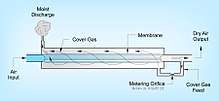
vapor builds on the membrane and migrates through to the opposite or low pressure, side. A dry cover gas is flowed across the low pressure side and absorbs the water on the membrane. After absorbing the water, the cover gas is discharged to the atmosphere. The cover gas is generally taken from the output of the dryer. The membrane is typically a series of small tubes collected in a bundle within an outer housing.
If set-up and operated properly, membrane dryers can produce extremely low dew points. For this reason they are very common in laboratories, medical facilities and specialty manufacturing environments where limited amounts of high quality compressed air is required. They are usually set up as a point-of-use dryer and provide the best service when used in a second or third stage role. The delicate nature of the equipment and how it is used makes them generally unsuitable for more mainstream or industrial applications.
References
- ↑ US5522150A, Schultz, "Modular air dryer for compressed air with dessicant", published 1996
- ↑ US5286283A, Goodell, "Air dryer for compressed air system having a serviceable oil filter", published 1994
Books
- Elliott, Brian S. Compressed Air Operations Manual, McGraw-Hill Books, 2006 ISBN 0-07-147526-5
- Barber, Antony, Pneumatic Handbook-Eighth Edition, Elsevier Science, 1998 ISBN 978-1856172493
- Compressed Air Handbook-Sixth Edition, Compressed Air and Gas Institute, 2003 ISBN 0974040002
- Improving Compressed System Performance-Third Edition, U.S. Department of Energy, 2017
- Best Practices for Compressed Air Systems Manual-Second Edition, Compressed Air Challenge, 2007 ISBN 978-0615386829